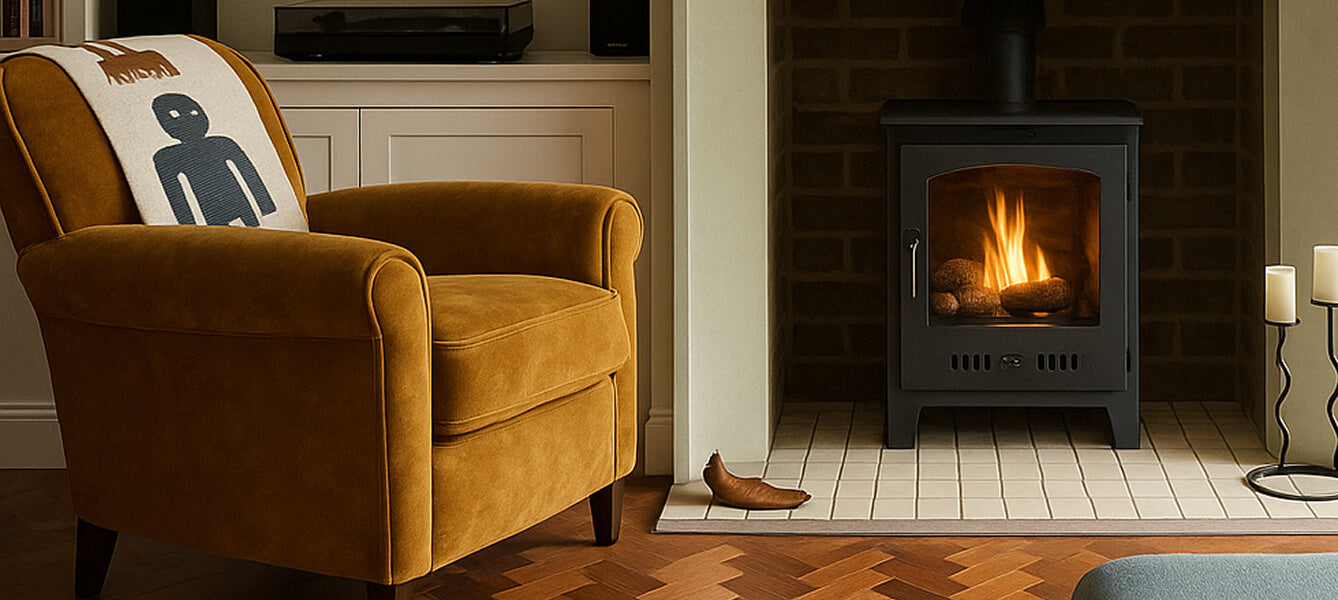
A Guide to the Best Heating Options for Your Home
We’re in the midst of a heating crisis in the UK, so many of us are looking for cheap and low-cost heating options for homes.
And when switching on the gas is turning out to be so unbelievably pricey, we thought we’d share some alternative ways to warm up your cold house.
Whether you're "self-disconnecting" or just trying to be a little more thrifty with your heating bills, we have some heating options for your home that could save you £££s.
Check out our best heating options for your home to help you get through the cold winter months this year.

How do you warm up a cold house?
Switching the heating off altogether can cause a range of additional problems for your home, from dampness to condensation, which can lead to mould and respiratory disorders.
Wherever possible, it's better to keep the heating low to keep the general chill out of the air.
However — for some — the option of putting the heating on at all just isn’t viable.
Therefore, consider building a homemade heating system that requires just a couple of candles and a couple of plant pots.
Create a terracotta heater
Tealights — those flat, round little candles — are widely available in Pound shops and could be the key to keeping warm this year.
You can get 25 tealights for as little as £1 in some stores — each tealight provides up to 3 hours of light.
But it’s not just light produced by these cheap little candles — it’s heat. And you might be surprised by the level of warmth you can achieve with a single tealight and a terracotta plant pot.
You’ll need:
- A tea light
- A saucer
- A terracotta plant pot — any size will do; just avoid plastic!
- A lighter
And that’s it.
How to make your own tea light heater
Place a tealight on a saucer and light it. Cover the burning candle with an upturned plant pot — it needs a large draining hole to facilitate combustion.
No need for anything else.
Within ten minutes, the plant pot will be too hot to touch, radiating warmth into the room like a mini radiator.
It really does work and could save you a fortune this winter.

What is the most effective home heating system?
There are several ways to heat your heat — and the method you choose is down to the system you inherit when you move into your home and the available fuels. For example, many high-rise flats have removed gas from individual residences, with many large blocks offering heating from a centrally shared source.
However, most homes have the options of:
- A gas boiler, including a combi-boiler
- An air-source heat pump
- Electric space heaters
- Wood-burning and coal-burning stoves (or open fires)
- Bioethanol
Gas boilers
Gas boilers are generally considered to offer pretty efficient ways to warm your home.
However, at the current price, gas has become unaffordable for many, meaning sitting in a cold house all day.
If you have a combi-boiler, you can heat your water and home from the same source.
Air-source heat pumps
Air-source heat pumps are relatively new to the UK, offering highly efficient heating by extracting heat energy from the air outside (even when it's freezing).
Also known as air-to-water source heaters, they work by transferring heat from the outside to a water reservoir, which is pumped around your radiators or underfloor heating. Some systems can also heat your water, while others are available in air-con-type units.
Space heaters
Space heaters are usually electric, but you can also get Calor gas-powered standalone heaters.
Generally speaking, electric space heaters are considered expensive to run and, therefore, not a great option for heating your home.
However, if you're working from home, you'll spend most of the day in one room, and — in this case — it doesn't really make sense to heat the entire house, which could be considered a waste of money.

Of course, you can switch off the radiators in unused rooms, but you’re still running your boiler for one room, which isn’t particularly economical right now.
So:
It's relatively straightforward to calculate the cost of running a space heater, based on the kW power of the heater.
Let’s say you buy an oil-filled electric radiator, which runs at 2kW at full power.
How much does an electric space heater cost to run?
The average cost of electricity right now (December 2022) is 34p/kWh, which is at least three times more expensive than it was this time last year. Thus, running an electric heater at full power for an hour would cost 68p per hour.
That’s fairly eye-watering.
However, most space heaters don't run continually, so they wouldn't use that much power. Fan heaters are generally considered the most expensive electric space heaters to run.
Oil-filled electric radiators
Oil-filled electric radiators are actually very good because the electric element only runs until the oil reaches the desired temperature. And from there, electricity is used to top up the temperature.
You should therefore consider:
- the temperature outside,
- the effectiveness of your insulation, and
- the warmth you want to reach,
These affect how regularly your oil-filled electric radiator clicks off and on. In my office, my oil-filled radiator runs for around ten minutes per hour (at a more affordable 6p per hour).
I use an oil-filled electric radiator in my home office, which has cost around £1.50 a day to run so far this winter, which is fairly reasonable.
Obviously, in old money, that's a shocking amount, but when you consider how much it costs to run the gas boiler right now (almost £10 a day!), it's not too bad.
So, if you're looking for heating options for a small home or just heating individual rooms, oil-filled radiators can be a good choice.

Wood- and coal-burning stoves
Many people are opting away from mains-supplied energy to heat their homes this year. And that's totally understandable, which is why many of us are looking at the option of a real fire in our homes.
Wood- and coal-burning stoves offer a fierce heat and can warm the entire home if your water supply is connected to your stove.
However, the cost of wood and coal has increased like everything else. It can be surprisingly challenging to get a definitive price for wood and coal — try Googling "cost of firewood", and you'll find it difficult to find a website that gives a price!
But:
Ideal Home states that a cubic metre of firewood (containing around 300 seasoned logs) costs about £125. If you use five logs a day, that will last around two months, which is relatively reasonable.
However:
Remember that burning wood and coal contributes to air pollution - even correctly seasoned wood. And there's a lot of soot and ash to clear up each time you run your fireplace.
Bioethanol fireplaces
Bioethanol fireplaces are relatively new to the UK, but you might consider them the latest trend in eco-friendly heating.
A standard-sized bioethanol fireplace warms your room more gently than a wood or coal burner, but if you buy the right size fireplace for your space, you'll enjoy a lovely, cosy warmth that's more than enough.
Amazingly, bioethanol fireplaces don’t need a chimney or flue — that’s their real selling point. There’s no costly installation, and burning bioethanol fuel is carbon neutral.
A bottle of bioethanol costs around £3.50 per litre and burns for 4 to 5 hours, depending on how fiercely you let the flame burn.
Pair your bioethanol fireplace with a stove top fan, and you have a real flame that warms your room beautifully — with none of the existential guilt of burning fossil fuels.
Check out our article, where we compare the costs of running gas, electric, and bioethanol heaters, for more information.
What is the best heating source for your home?
It’s impossible to say which heating source is best for your home, but it is possible to identify which is right for you.
Electricity and gas are convenient because they're usually delivered directly to your home. You can reduce your bills with solar panels, air-source heat pumps, and buying a brand-new boiler.
But, of course, these options require a pretty significant investment.
How about a real fire?
Having a real fire in your home is a particularly attractive and popular feature, but if you’re burning wood or coal, you have to consider the potential environmental impact.
Bioethanol is a good alternative, but — of course — you need to invest in a new fireplace — although installation is much cheaper and easier than a fossil fuel burner.
Bioethanol fireplace inserts and fire baskets are more affordable than full-scale fireplaces and offer plenty of heat to warm up your room. These are standalone units, some of which could be used on a tabletop, making an attractive centrepiece for your home.

Find the Best Heating Option for Your Home
While all the home heating options we've explored have pros and cons, it's helpful to acknowledge that we have choices.
You might feel that the gas and electricity companies are taking advantage of the high prices — remember, there are greener and more economical options.
For more information about bioethanol burners, check out our FAQs or video how-tos.
Thanks for reading!
